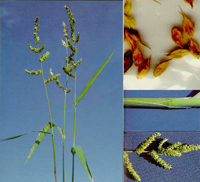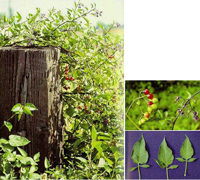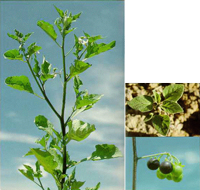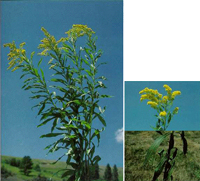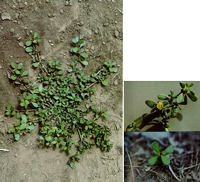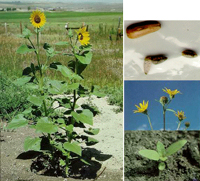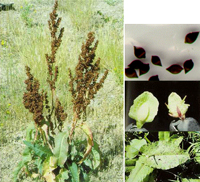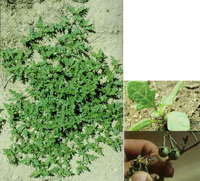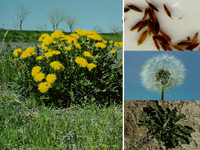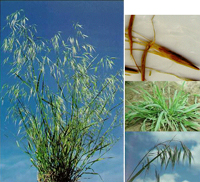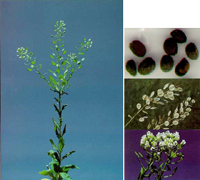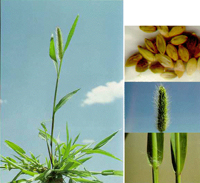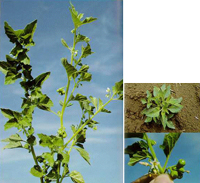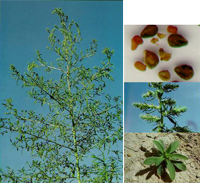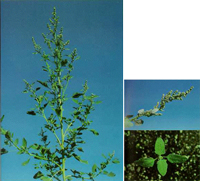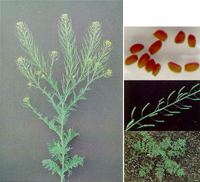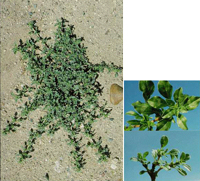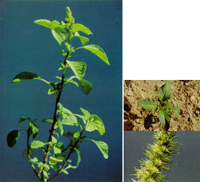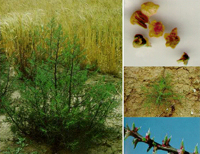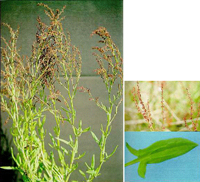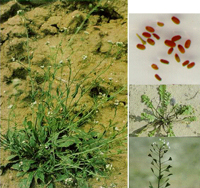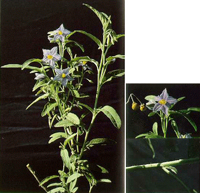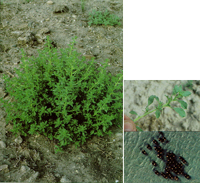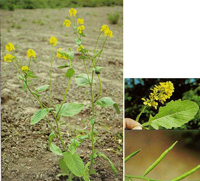Contact Us
Wendy Karol Cecil
Research Associate, Plant Sciences
University of Wyoming
1000 E. University
Agriculture Bldg 4031
Laramie, WY 82071
Phone: (307) 766-2243
Email: wcecil@uwyo.edu
Weeds Study Guides
Wyoming FFA Agronomy Contest
Common Weeds
Click on image for full size picture.
Barnyard Grass
|
Poaceae (Grass Family) Barnyard grass is a vigorous, warm season annual grass reaching 1 to 5 feet in height with bases of many stems reddish to dark purple. Leaf blades are flat, 3/8 to 5/8 inch broad, smooth, and without a ligule or auricles and ligules. Panicles are often reddish to dark purple. Spikeslets are crowded; awns might be absent or can be found up to 1 inch long, stiff scattered hairs are common. Barnyard grass was introduced from Europe and has become widespread throughout our region, especially in irrigated crops, gardens and other cultivated areas. Leaf sheaths are open lacking auricles and ligules. Seedheads, often purple, contain crowded large seeds. |
Bittersweet Nightshade
|
Solanaceae (Nightshade family) A trailing or climbing perennial with spreading stems up to 10 feet. Leaves dark green to sometimes dark purplish, 1 to 4 inches long, often with one to several lobes or leaflets at the base. Flowers are star-shaped, having purple petals and prominent yellow or orange anthers. Fruits are bright red, egg-shaped berries, arranged in open clusters. It is a native of Europe that is widely distributed throughout much of North America. It is typically found growing in moist waste areas, in fence rows, along drainage ditches and waterways; and may form large colonies or thickets. it also becomes established in orchards, vineyards, and residential landscapes. all parts of the plant are toxic. Children seem to be especially attracted to the bright red berries, which may cause poisoning if eaten in sufficient quantity. |
Black Nightshade
|
Solanaceae (Nightshade family) An annual 6 to 24 inches tall with glabrous or appressed-hairy stems. Leaves are ovate, smooth to wavy-edged and tapered to the tip. Flowers resemble those of the potato and tomato and are white to pale-blue, 1/4 to 3/8 inch wide, borne in clusters. Calyx is scarcely enlarging, not cupping the fruit. It is a native of Europe, is a weed of waste places and cultivated fields. The berries frequently become mixed with harvested commodities such as dry beans and green peas, decreasing crop quality. The green (immature) fruit and foliage contain toxic alkaloids. In recent years, nightshades have become troublesome in fields where certain herbicides have been used to control other weeds but are weak on nightshade. |
Canada Goldenrod
|
Asteraceae (Sunflower family) Canada goldenrod is a perennial growing to heights of 4 feet. spreading by creeping roots and seeds. Alternate leaves surround the central stems and are gradually reduced upwards. Leaf blades are entire or commonly toothed and have three veins on the upper surface. Flowers are yellow, borne on numerous small heads with overlapping involucral bracts. Thirteen ray flowers are common, but there may be as few as 10 or as many as 17. Seeds are tipped with a circle of white hairs. Canada goldenrod, a native of North America, is common in the U.S. and Canada. The plant is often seen along roadsides, stream banks, and along ditches. The extensive root system makes it a difficult plant to control. It seldom reaches densities that are a problem in rangelands. Flowering occurs from August to October. |
Common Purslane
|
Portulacaceae (Purslane family) A fleshy, prostrate annual with smooth reddish or flesh-colored stems. Branches radiating from a central rooting point reach lengths in excess of 12 inches and form dense vegetative mats. Smooth, shiny, succulent leaves are some what teardrop-shaped, wider at the tip than at the base. five-petalled yellow flowers are borne singly in leaf axils, and open only in sunshine. Numerous, tiny, black seeds are produced in capsules resembling the flower buds. Introduced from Europe, common purslane has become a troublesome weed in cultivated fields and gardens. it is especially persistent in soils that remain moist much of the time. production of seed throughout the growing season, and the ability to root again after cultivation make this plant especially difficult to control. Seeds can remain dormant in the soil for years before germinating. Purslane has limited value as a potherb, but is rarely eaten. |
Common Sunflower
|
Asteraceae (Sunflower family) The common sunflower is an annual, 1 to 10 feet tall. Stems are erect, simple to much branched and rough. Leaves alternate and are simple rough, hairy, ovate or heart-shaped, with toothed edges. The flowers are showy, with yellow to orange-yellow ray flowers and brown or dark reddish-brown disk flowers. Achenes, gray to brown, are 1/4 inch long, wedge-shaped, some what flattened to 4-angled, smooth except for a few short hairs at the tip. Native to North America, sunflowers have been cultivated since pre columbian times for its edible seeds. They are common weeds of roadsides, fence rows, fields, pastures, and waste areas. Flowering is from July to September. |
Curly Dock
|
Polygonaceae (Buckwheat family) A robust tap-rooted perennial growing 2 to 5 feet tall. Stems are erect, generally unbranched on the lower half, often reddish and slightly ridged. Leaves are mostly basal, with curly or wavy margins, elongated, 4 to 12 inches long and lack hairs. Flowers are small and in dense, green, spicke-like, terminal and axillary clusters. Inflorescence are even entire plants turn reddish-brown at maturity. Individual seeds are enclosed in a papery, sometimes corky, winked structure, 1/8 to 3/16 inch long, that facilitates distribution by wind or water. |
Cutleaf Nightshade
|
Solanaceae (Nightshade family) This plant is an annual, 4 to 24 inches tall, branched from the base, with illsmelling foliage. Leaves are deeply lobed and may have short pubescence. Flowers resemble those of potato and tomato and are small, have white petals and a somewhat enlarging calyx and are arranged in groups of three. Fruits are green. Cutleaf nightshade is native to North America east of the Cascade Mountains to the Great Plains and is a weed of waste places and cultivated fields. The plant contains toxic alkaloids. Cutleaf nightshade is resistant to many commonly used herbicides. |
Dandelion
|
Asteraceae (Sunflower family) Dandelion is a perennial herb with milky juice from an often branched taproot up to several feet long. Reproduces by seeds and by new shoots from the root crowns. Leaves are clustered at the top of the root crown. They vary in size, from 2 to 12 inches long, divided into pairs of lobes, which are pointed or blunt at the tips. The flower heads are 1 to 2 inches across, composed of yellow petal-like ray flowers. Heads are solitary. Achenes are 1/8 inch long, five-to eight-ribbed, the apex ends in a slender beak two or four times as long as the body of the achene, with parachute-like hairs at its apex. The common dandelion is native to Europe, but is now cosmopolitan. It grows in moist sites, including lawns, meadows, pastures, and overgrazed areas. It is good forage on the ranges and is especially relished by sheep and cattle. Flowering occurs almost nine months of the year. |
Downy Brome
|
Poaceae (Grass family) Downy brome is an annual or winter annual, 4 to 30 inches tall, reproducing by seed. Leaf sheaths and flat blades are densely covered with soft hair. Ligules are short. Inflorescence is dense, slender, usually drooping, 1-sided, 2 to 6 inches long. Spikelets are nodding, slender 3/8 to 3/4 inch long. Awns are 3/8 to 5/8 inch long, usually purplish at maturity. Downy brome was introduced from the Mediterranean region in packing material and first found near Denver, Colorado. It is now widely distributed throughout North America and is common along road sides, waste areas, misused pastures and rangelands, and cultivated crop, areas. Although downy brome is considered an invader, on certain intermountain ranges it has become the primary green forage utilized by livestock. The plant competes with more desirable perennial grasses for moisture because of it winter and early spring growth habit. After maturity it becomes a nuisance and a fire hazard. It is also a common crop seed contaminant very difficult to separate from grass seed. |
Field Pennycress
|
Brassicaceae (Mustard family) Field pennycress is an annual; 6 to 18 inches tall; basal leaves lanceolate, simple, entire to loved, inflorescence a raceme. Petals are white, in clusters on the ends of branches; fruit a pod, circular in outline, obviously winged, rounded, deeply notched at the top, seeds 2 or more on each chamber. Field pennycress was introduced from Europe. It is a very troublesome weed in grain fields and is also found growing in waste places, roadsides and other disturbed areas. A strong odor is associated with this plant causing dairy animals eating field pennycress to produce a bitter-flavored milk. Field pennycress flowers from late spring to early summer. |
Yellow Foxtail & Green Foxtail
|
(Grass family) Yellow foxtail is a tufted annual, 1 to 3 feet tall, with erect stems that branch at the base. The leaf blade is smooth, 1/8 to 3/8 inches wide with distinct hairs on leaf margins near the base. Leaf sheath smooth, 2 to 8 inches long and 1/2 inch wide. Panicles cylindrical, with crowded spikelets that are subtended by 6 to 10 long yellowish bristles. Seeds are broadly oval, green to yellow to dark brown, coarsely roughened and approximately 1/8 inch long. Green foxtail is generally shorter in height with roughened leaf sheaths, without hairs, and has much smaller seeds. These plants are native to Eurasia, but common throughout most of North America (green foxtail is more common than yellow foxtail in the western U.S.) They are often serious problems in spring-seeded alfalfa, row crops, and small grain crops, but they also occur along roadsides and in waste areas. These plants are responsible for reduction in yield, increased cleaning costs, and expensive control measures. Flowering and seed production occur July to September. |
Hairy Nightshade
|
Solanaceae (Nightshade family) Hairy nightshade is an annual, 12 to 24 inches tall. Foliage is spreading, hairy, and may feel sticky when handled. Flowers resemble those of potato and tomato and have 5 white petals, and an enlarging green calyx. They are arranged in clusters. As the fruit matures, the calyx cups the lower half of the greenish or yellowish fruit. Hairy nightshade, a native to South America, is a widespread weed of waste places and cultivated fields. The plant contains toxic alkaloids, especially in the berries. hairy nightshade causes problems in field crops similar to those described for black nightshade. |
Kochia
|
Chenopodiaceae (Goosefoot family) Annual, 1 to 6 feet tall, stems much branched, round, slender, usually soft-hairy, but occasionally smooth, often red-tinged. Leaves alternate, lance shaped, entire 1/2 to 2 inches long, margins fringed with hairs; the upper surface is usually smooth, the lower surface usually covered with soft hairs; leaf blades with 3 or 5 prominent veins. Flowers are inconspicuous, sessile in the axils of upper leaves and form short, dense, bracted spikes. Seed wedge-shaped, dull brown, slightly ribbed and approximately 1/16 inch long. Native of Asia, introduced from Europe, kochia has escaped from cultivation as an ornamental and is now found throughout North America. It is common in cultivated fields, gardens, roadsides, ditch banks and waste areas throughout the western U.S. While it is usually considered an objectionable weed, kochia is readily grazed by livestock. it sometimes contains high nitrate levels and can be toxic. Flowering and seed production may occur from July to October. |
Netseed Lamsquarter
|
Chenopodiaceae (goosefoot family) Extremely variable annual, 1 to 6 feet tall, stems erect, much branched and often striped with pink or purple; leaves alternate, the lower often wavy margined to somewhat lobed, the upper narrower and often entire, undersurface white to grayish-mealy. Flowers are small, inconspicuous, greenish-gray, mealy, crowded in axils and at tips and branches of stem calyx strongly keeled, seeds numerous, dark gray to black with a honey combed surface. Netseed lambsquarters is common in cultivated fields, gardens, and waste areas. It is a very competitive weed because of its rapid growth and high water use. Lambsquaters also serves as a host for the beet leafhopper which transmits curly top virus to sugarbeets. Netseed lambsquaters is often eaten in salad or as greens when the plant is young and tender. Flowering and seed production may occur from July to September. |
Pinnate Tansymustard
|
Brassicaceae (Mustard Family) Pinnate tansymustard is a winter annual, 4 to 32 inches high; leaves alternate, pinnately dissected; stellate pubescence; inflorescence a raceme; petals yellow or yellowish green to cream ; siliques less than 3/4 inch long; pods clavate or linear; to rows of seeds in each seed pod. A natvie growing in waste places, fields, roadsides, and other disturbed sites. Tansymustard spreads by seeds from early to late summer. |
Prostrate Pigweed
|
Amaranthaceae (Pigweed family) An annual with generally prostrate stems radiating in all directions from a central taproot. Main stems are usually 12 to 18 inches long with shorter secondary branches. All stems are somewhat fleshy and pliable, nearly smooth, and usually red to purple. Leaves are approximately 1/2 inch wide and oval, with the tip broader than the base. Flowers are in small congested clusters in the leaf axils. Long terminal flower spikes are absent. Seeds are shiny, black, lens-shaped and approximately twice the width of tumble pigweed seeds. Prostrate pigweed was possibly introduced from tropical America, adapting well to our area. It occurs mostly in disturbed or cultivated soils, and is often associated with tumble pig weed. it is a common garden weed. |
Redroot Pigweed
|
Amaranthaceae (Pigweed family) A course erect annual, usually 2 to 3 feet tall. Lower stems are often red or red-striped, with color continuing down the taproot. Leaves have long petioles and prominent veins. they are somewhat broad and lance-shaped, and often become reddish. Individual flowers are small, green and tightly arranged in large, branched, spike-like, terminal clusters. Smaller axillary flower clusters may also occur. Flower clusters are full of stiff, spine-like scales, making this pigweed additonally undesirable in hay. Seeds are small, black and shiny. Redroot pigweede is widely disrtributed throughout the western states, commonly found in cultivated lands, gardens, and waste areas. Germination occurs anytime during the frowing season when soil moisture is sufficient. |
Russian Thistle
|
Chenopodiaceae (goosefoot family) A rounded, bushy, much branched annual, 1/2 to 3 feet tall, reproducing by seed. Stems are usually red or purple striped. Leaves are alternate; the first are long, string-like and soft, with later leaves short, scalelike and tipped with stiff spine. Inconspicuous green flowers are borne in axils of upper leaves, each flower accompanied by a pair of spiny bracts. Seeds are spread as mature plants break off at fround level and are scattered by the wind as tumbleweeds. Rapid germination and seedling establishment occur after only brief and limited amounts of precipitation. Since russian thistle was introduced (from Russian) in the late 1800's, it has become one of the most common and troublesome weeds in the drier regions of the U.S. it is well adapted to cultivated dry land agriculture, but is also found on disturbed wastelands, overgrazed rangelands, and even some irrigated cropland. |
Sheep Sorrel
|
Polygonaceae (Buckwheat fmily) Perennial with slender creeping rootstocks. Stem somewhat woody at the base, 1/2 to 2 feet tall, little branched. Blade of the lower leaves somewhat arrow-shaped with 1 to 2 conspicuous basal lobes. Upper leaves are more slender and sometimes without basal lobes. The slender petiole has a papery slender and sometimes without basal lobes. The slender petiole has a papery sheath ot point of attachment to stem. Leaves and stems have a sour taste. Flowers are borne in branched terminal clusters. The plants are dioecious, the male flowers are orange-yellow and the female flowers are red-orange. The fruits are small, 3-angled, enclosed in 3 reddish, persistent flower parts. the triangular seeds are polished mahogany colored. Sheep sorrel is native to Europe and can be found throughout the West. While apparently thriving on acid soils, it has adapted to ther soils and various frowing conditions and often occurs in lawns, field, gardens, and along roadsides. |
Shepherdspurse
|
Brassicaceae (Mustard family) Winter annual or annual, 3 to 18 inches tall with stems erect, slender, one to several from a basal rosette, hairy below and smooth above. Leaves are alternate with the lower ones usually deeply lobed, the upper ones are few, lance-shaped, toothed or entire, clasping the stem with a pair of ear-like lobes at the base. The flowers are white, small and usually found at the end of elongated racemes. Fruits more or less hear-shaped, two-celled; seeds many, many very, small, oblong, reddish-brown with a single ridge on each side. Native of Europe, shepherdspurse has become well-established throughout much of the U.S. and Canada. It is common in cultivated fields, gardens, waste areas, poorly maintained pastures and on roadsides. This plant is one of the first to flower in the spring. flowering and seed production may occur from April to September. |
SilverLeaf Nightshade
|
Solanaceae (Nightshade family) A perennial, 1 to 3 feet tall, spreading by rhizomes or seeds. Stems are sparsely covered with short yellow thorns. Leaves and stems are covered with dense short hairs that five the foliage a gray or silvery appearance. Leaves are narrow, lance-shaped, with entire to wavy margins. Flowers are 3/4 to 1 inch wide with violet to light blue (sometimes white) petals. The mature fruit is ayellow or dull orange berry, which may eventually turn blackish. Silverleaf nightshade is native to the central United States, but has spread to other areas where it is found on rangeland, in pastures, waste areas, and cropland. The berries and foliage are poisonous to livestock. |
Tumble Pigweed
|
Amaranthaceae (Pigweed family) An annual species, somewhat prostrate to spherical and erect, much branched, 6 to 36 inches tall. Leaves usually have narrower blades and shorter stalks than those of prostrate pigweed. Stems are usually light green rather than red, more erect, more intricately branched, and general aspect of mature plants is more spiny than prostrate pigweed. Flowers are borne in small spiny clusters at the base of leaves, not in long terminal spikes as in the case of redroot pigweed. Seeds are black, shiny, lens-shaped and 0.7 to 0.8 millimeters wide. Tumble pigweed is found primarily in cultivated or disturbed sites. This plant is a prolific seed producer and the seed can be spread great distances when mature wind-blown plants break off and tumble along the ground. |
Wild Mustard
|
Brassicaceae (Mustard family) An annual or winter annual 1 to 3 feet tall. Stems are erect, with stiff hairs, at leas on lower portions. Leaves are 2 to 8 inches long, 1 to 4 inches wide, lower ones deeply lobed, upper leaves are merely toothed and may be short-stalked or stalkless (but not clasping). Flowers are yellow with 4 petals. Seed pods (siliques) lack hairs, or 1 1/4 to 2 inches long, oval to round in cross section, and supported on short (1/10 to 3/10 inch) pedicels. Seed pods have a constricted beak above the uppermost seed. The beak of wild mustard is 3/10 to 6/10 inch long, obviously flattened (2-edged or 4-angled), and valves (pod halves) each have 3 to 5 prominent lengthwise veins. Pods somewhat spreading. Wild mustard is adventive from Europe; now widespread, infesting roadsides, cultivated fields, ditch banks, and waste areas. |
Contact Us
Wendy Karol Cecil
Research Associate, Plant Sciences
University of Wyoming
1000 E. University
Agriculture Bldg 4031
Laramie, WY 82071
Phone: (307) 766-2243
Email: wcecil@uwyo.edu

